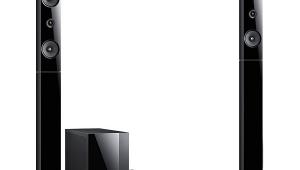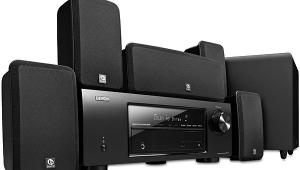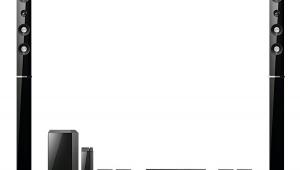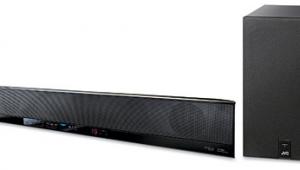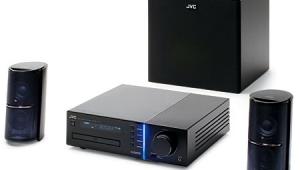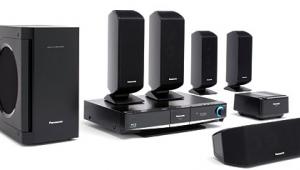Denon S-301 HTIB
As soon as I added a subwoofer to my stereo desktop system, the illicit charms of 2.1-channel audio began to woo me like the moon pulling on the tide. So, I was primed and ready when Denon's S-301 HTIB system arrived with its two speakers, sub, and controller.
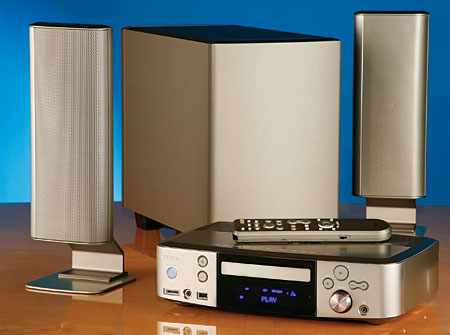
Still, I had questions. It's one thing to have a little 2.1-channel action at your desk and quite another to let it into your home theater system. Would a system based on Dolby Virtual Speaker technology stand up to full-bore, make-my-jaw-drop movie consumption? And would my intravenous music drip keep dripping when I plugged an iPod into the front-panel docking jack?
Denon has prior experience with Dolby Virtual Speaker. I reviewed the good-sounding D-M71DVSXP HTIB in these pages more than two years back. That earlier product is a hard act to follow—I've yet to see a compact home theater system with more gorgeous aesthetics. However, the S-301 does raise the rated front left and right wattage from 20 to 70, the sub from 100 to 140, and the price from $999 to $1,599.
Not a Pain, Not Traditional
Like any decent one-carton home theater solution, the S-301 is easy to set up. Two screws bind each speaker to its platform. You'll need to connect your video display, of course, preferably via HDMI, although the controller also offers analog video interfaces. A very thick and sturdy multipin cable connects the controller and subwoofer and carries power and the video, audio, and control signals between them. Two 16-gauge speaker cables with proprietary 0.5-inch-wide flat connectors run between the sub and the speakers. You can open up the connectors to accept different lengths of cable, if need be. Plug the sub into the wall, and you're done. If you let the sub power the controller, you'll reduce the system to a single power connection, leaving outlets free for more important stuff, like a set-top box, or a lava lamp, or possibly a blender, if you like pia coladas as much as I do.
I stood back and admired the system. The controller looks vaguely like a high-end table radio. Its disc drawer—gray metal like most of the front panel—stands out amid the dark center panel, and a blue fluorescent display is located below the drawer. The controls are generously sized and asymmetrically arrayed on either side of the drawer/display panel. Denon has put some thought into the sensible layout. It guides you quickly to what you need, shaving precious seconds off your use of the system.
The remote control makes use of both its front and back sides. On the front are oft-used controls in a nontraditional layout. Turn the remote over and flip aside a door, and you'll find a selection of tiny but widely spaced buttons for additional functions.
The mirror-imaged speakers' rounded side curves echo those of the controller for a unified look. Their construction is also similar, with a solid gray metal front blending into gray plastic at the sides and back. The aluminum grilles are nondetachable. The speakers feature solid-aluminum pedestals, threaded inserts for wall mounting, and a two-way driver array.
The convex-fronted sub has a downward-firing 8-inch driver, jacks for control, power, and speakers, and absolutely nothing else—no glowing LED, not a single control, not even a power switch. Clearly, Denon designed both the sub and the controller to include just the essentials. Advanced features appear only in the control menu and on the back of the remote.
Denon is gambling that folks who pay top dollar for a self-contained home theater system want it that way. This system is aiming squarely at the nontraditional, non-audiophile, non-videophile, national-advertising-susceptible market established by—well, you know. And if you don't, I'm not going to tell you. Bad karma.
Versatile and Virtual
Look-and-feel distinctions start as soon as you press the red-ringed power button. It blinks and turns blue. When you load a disc and press play, the play button lights up blue and then fades to nothing.
If you want to start using this system without changing a single thing, you can; but, if you want to fine-tune it, you can do that, too. A three-position speaker-location control voices the system for on-shelf (default), on-wall, or freestanding use. The three-position room-damping control progressively dulls the treble to compensate for a range of acoustic conditions, from rooms with "many hard walls and strong reverberations" to those with "thick curtains and little reverberation." If you change the speaker-location control, the room-damping control will actively default to its middle setting, although you can also readjust it manually. Since my preferred speaker position is 2 to 3 feet out from the wall and my room is well damped, I picked the freestanding and minimum-room-reverb settings.
On the video side, DCDi video processing and an HDMI output are big pluses. There's a versatile gamma control, and you can set the black level to 7.5 IRE (the U.S. standard) or 0 IRE (Japan). The menu is structured with a next-level selection at the bottom of each submenu, so you can step through everything in linear fashion without having to repeatedly back up.
The heart of the system's technology strategy is Dolby Virtual Speaker. Any junk minisystem can claim to get faux surround out of two speakers. Usually, it sounds artificial, disorienting, and full of obviously false phasey effects. But, with DVS, the circuitry is specifically designed to use Dolby's own surround formats as input signals—including Dolby Digital, Dolby Pro Logic II, and Dolby Surround. Since Dolby knows its own technologies better than anyone, DVS has a head start on the competition. In practice, it works rather well, with a clean, natural sound. It isn't as good as using a real 5.1-channel system with speakers in the conventional positions—when you move out of the sweet spot, a singer's voice tends to move with you, for instance. But DVS delivers an oft-pleasing approximation of the true surround experience.
 According to Dolby, DVS processing places a phantom center between the front left and right speakers and virtual surrounds at 105 degrees to the left and right. In other words, a front-to-back pan should seem to move from the front speakers to a position just to the side and slightly behind you, although not actually to the back of your seating position.
According to Dolby, DVS processing places a phantom center between the front left and right speakers and virtual surrounds at 105 degrees to the left and right. In other words, a front-to-back pan should seem to move from the front speakers to a position just to the side and slightly behind you, although not actually to the back of your seating position.
DVS has two settings: reference and wide. The latter places the front speakers—as perceived by the listener, not their actual position—a little farther apart. After a day of casual break-in listening, I moved the two speakers closer together, with 50 inches between them and each one about 80 inches from my seat. This worked well with both the reference and wide settings—I could go wide without the front soundstage diffusing into vapor. Even so, I preferred the reference setting for its absolute rock-solid center image. There was no feeling of a hole in the middle.
This Is Your iPod on Screen
The front-panel iPod dock uses Apple's proprietary 30-pin connector to communicate with the player. It feeds the digital audio signals directly into the system's digital-to-analog converter, thus avoiding the analog headphone output and its puny preamp circuit. The result is total transparency within the limits of the compressed (or other) audio files. Denon's logo appears on the iPod screen, while the video display takes over with a graphic display that mimics the player. You can sit across the room with the remote and use its controls—menu, play, etc.—to key in familiar iPod commands. The system accesses photos from the iPod or any USB-connected storage device.
However, there are some limitations. You can't use the iPod unit's controls while it's connected. Because the front-panel display shows only current-track information, the video display has to be on for you to use the menus. And the song menu—though correctly alphabetized in the iPod interface and the iTunes computer software—follows the alphabetical order of the artist listings, not of the song titles themselves.
Nonetheless, I became so addicted to Denon's iPod interface that I rarely played a CD. If I wanted to hear something, I'd rip it, bump it to the iPod, and listen to it that way.
Sound quality was good. At the freestanding-speaker and low-damping settings, I found it to be coherent and comfortable up to a moderate volume level. For me, that meant a setting of –20 out of a range of –60/+9.
Unlike many HTIB subs, this one could carry a tune at low to moderate volumes. During The Amityville Horror, when a sudden bang punctuates a falling doll, the impact resounded through the soundfield like the hammer of fate. Surround effects were not as specific as those in a conventional 5.1-speaker system, but they were present.
The distinctive textures of my heavy-metal test tracks ("Fortune Teller" by the Who, "Enter Sandman" by Metallica, and "Mississippi Queen" by Mountain) emerged separately. Coloration was subtle. Comparing this system with my much more costly and elaborate reference components would be like comparing top-quality animation with top-quality film-based cinematography—the shadings were all there; they just felt a little different.
I think I'll hold onto my rack of big, black reference components—I'm old-fashioned that way. But, for sound quality, adjustability, and features, the S-301 is my pick as the system to beat in the small world of Dolby Virtual Speaker–based systems.
* Audio editor Mark Fleischmann is also the author of the annually updated book Practical Home Theater (www.quietriverpress.com).
Highlights
• 2.1-channel surround sound
• iPod plugs into front panel
• System remote operates iPod
- Log in or register to post comments
